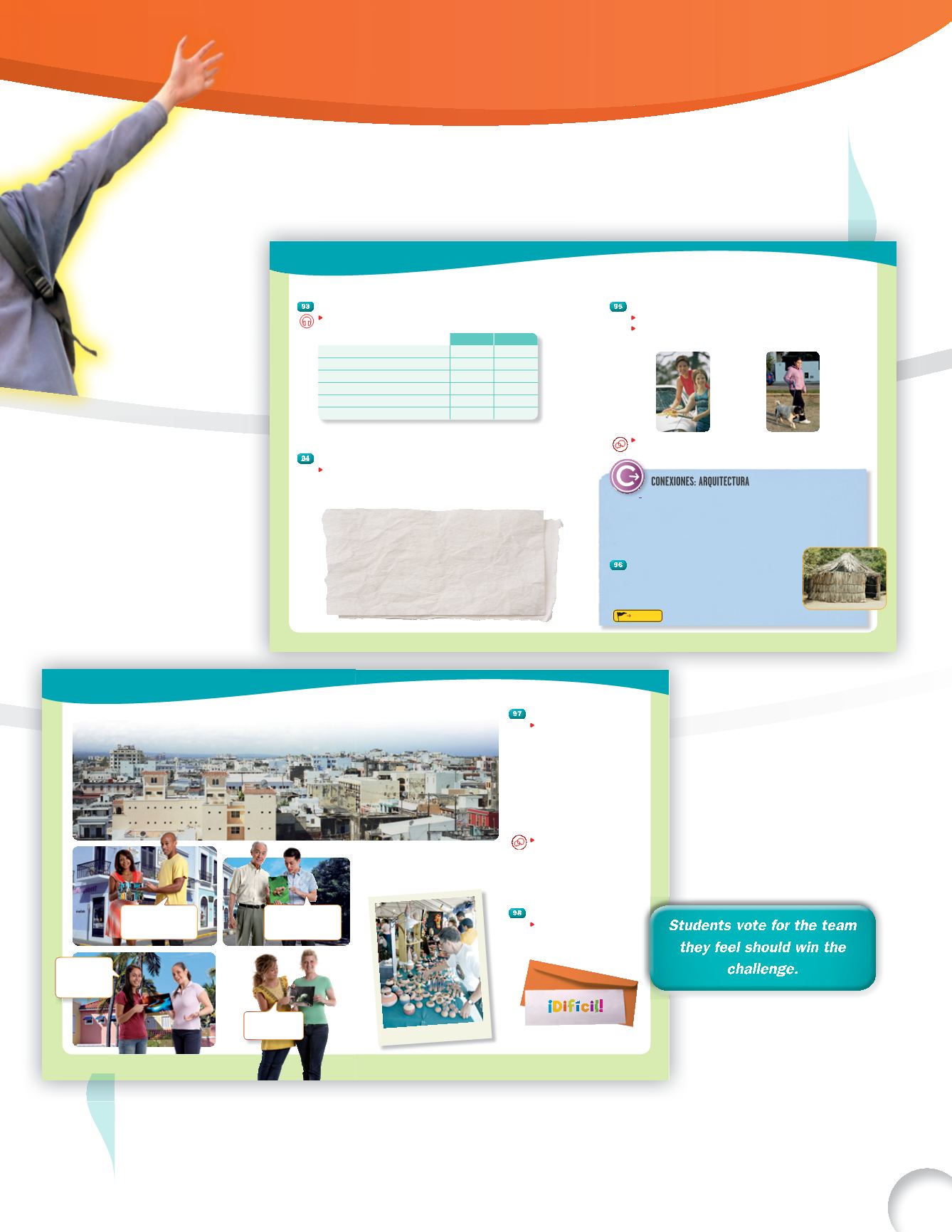

7
134 ciento treintaycuatro
El encuentro
Aquíestamosen la
cueva. ¡Haypecesen
lascuevasdeCamuy!
En el Viejo San Juan
The fourpairs return toOldSan Juan.Theyallbring theproofof their completed tasks.
Whowillwin the challenge inPuertoRico?
Mira,mitíayyo
estamosenuna
canoaen labahía.
Nosotrasprendemos
la luzde labahía.
Tenemos fotosdecoquíes
en lacasade la señora
García. Estánencima,al lado
ydebajode losmuebles.
En la fotoestamosal ladode
lacasamáscoloridadelViejo
SanJuan.Susparedes son
demuchoscolores.
ciento treintaycinco 135
Al llegar
Escribe.
As each pair reaches
the finish line, local journalists are
waiting to interview them. Write
questions for the journalists to ask.
Be sure to mention:
r
The names of each pair and a brief
description of each person.
r
Where each pair is from,and what
each person often has to do and feels
like doing at home.
r
Where items or people are in the
photo of the task.
r
How often the people do activities
similar to the ones for their task.
Habla.
Now use your questions
to interview a classmate. Your classmate
pretends to be one of the characters.
Record his or her answers. Then switch
roles.
Modelo
A.
¿Cómo te llamas?
B.
Me llamo Patricia.
A.
¿Y de dónde eres?
Las votaciones
Decide.
Which pair has done
the most difficult challenge?
Take a vote to decide.
Mercadodeartesanía enSan Juan.
Todo junto
(Putting It All Together)
Communicative activities integrate the vocabulary
and grammar taught throughout the unit.
132 ciento treintaydos
ESCUCHAR
LEER Y ESCRIBIR
Todo junto
El fin de semana de Janet y Tim
Escucha y decide.
Listen to Janet and Tim talking about what they do
on the weekends at home and decide who does each of these activities.
Una página misteriosa
Lee yescribe.
Diana found this page from an old diary in an antique shop in Old
San Juan. Read it,and answer the questions.
1.
¿Quiénescribe eldiario?
3.
¿Dónde está la casa?
2
. ¿Cómo es la casa?
4.
¿Qué tareas realizanestaspersonas?
Janet
Tim
1.
Pasar laaspiradora.
2.
Lavar losplatos.
3.
Cortarel césped.
4.
Cuidara lamascota.
5.
Escribir correoselectrónicosa losamigos.
6.
Hablarpor teléfono con losamigos.
25de octubrede1518
Mi casadeCaparraesbonita.Mimadreyyoestamosmuybienaquí.
La salay la cocina sonmuygrandes.Casi siempre tenemosqueabrir
lasventanasy laspuertasporqueaquíhace calor.Midormitorioespequeño.
Hayuna camayunamesitadenoche.
Mimadreyyo tenemosmuchas tareas.Todos losdíasellabarreel suelo.
Avecesyopreparounplato conarroz, carneyverduras.Aquí se llamaasopao.
También lavo losplatosy limpio la casa.
Tengoganasdevisitar labahía,peroestámuy
lejosdeaquí.Mitío JuanPonce
deLeón tieneuna casaallí. Sus cartas sonmuy interesantes.
ciento treintay tres 133
HABLAR Y ESCRIBIR
Un diario en fotos
Escribe.
Make a list of the activities you and your family do at home over three days.
Escribe.
Use photos or draw pictures of the most common activities,and write
a caption for each one. The caption should introduce the people in the photos,
and say how often each activity is done.
Modelo
Presenta.
Assemble the photos into a diary. Be creative! Share your diary
with your classmates in an oral presentation.
Las casas de los indígenas de Puerto Rico
EnPuertoRicohaydos tiposde casas indígenas: el
bohío
y el
caney
.
El
bohío
esde forma circulary tieneun techo
cónico.Notieneventanas.Tieneun suelo
de tierraypocosmuebles.
El
caney
esmás grandeyde forma rectangular.Tieneventanasymásmuebles
que el
bohío
.El
caney
es la casadelcacique,el jefede lacomunidad.
Piensa y contesta.
Answer the questions.
1.
¿Esta fotoesdeunbohíoodeun caney? ¿Cómo lo sabes?
(How can you tell?)
2.
¿Qué creesquehaydentrodeesta casa? ¿Quiénviveallí?
3.
Imaginaquevives enunbohío.¿Qué tareas tienes?
TU DESAFÍO
Listen to the questions for your
Minientrevista Desafío 4
on the website.
Mimadre
ymihermana
lavan el carro
muchasveces.
Yopaseo
ami perro
todos los días.
El encuentro
(The Encounter)
The four pairs meet again to discuss the challenges they completed,
using the grammar and vocabulary presented in the unit.
U
nit
W
alk-through



















